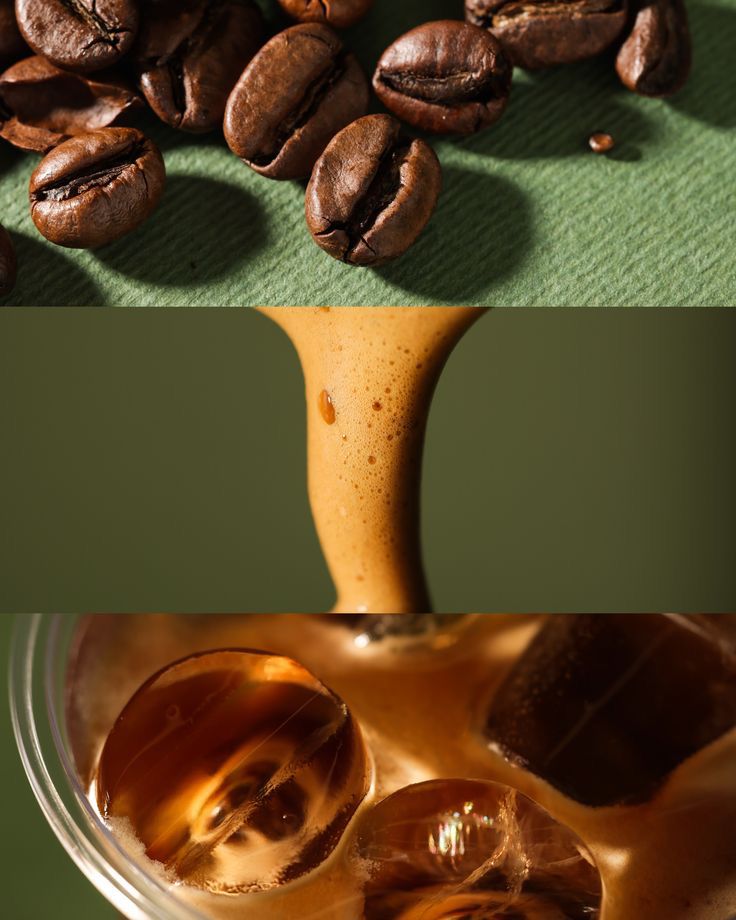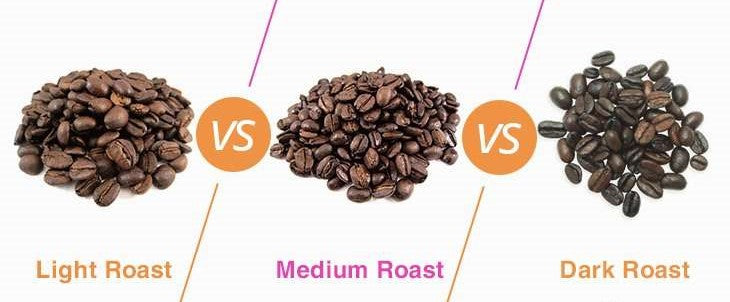أولا: المقدمة
أ. تعريف تحميص القهوة
تحميص القهوة هو عملية تحميص حبوب البن الخضراء الخام لإنتاج نكهتها الفريدة. يؤثر مستوى التحميص - خفيفًا، متوسطًا، أو داكنًا - على خصائص نكهة كل مزيج من القهوة.
تُحدد درجة الحرارة المُستخدمة في التحميص ومدة التحميص كمية النكهة المُستخرجة من حبة البن. كلما كان التحميص أغمق، زادت قوة النكهات؛ فالتحميص الخفيف يُعطي فنجان قهوة أحلى وأخف، بينما يُعطي التحميص الداكن نكهة دخانية ترابية مع لمسة من المرارة.
إن فهم الفروقات بين أنواع القهوة ذات التحميص الخفيف والمتوسط والداكن يُساعدك على تحديد النوع الأنسب لذوقك. ومع وجود مستويات تحميص متعددة، فلا عجب أن يتساءل عشاق القهوة عن نوع القهوة المُفضّل لديهم!
ب. أهمية تحميص القهوة في تحديد طعم ونكهة القهوة
تُعد عملية تحميص حبوب البن من أهم خطوات تحضير فنجان قهوتك المفضل. فطريقة التحميص تُحدد مذاق كل مزيج ورائحته ونكهته المميزة.
تُحمَّص أنواع القهوة ذات التحميص الخفيف على درجة حرارة منخفضة لفترة زمنية أقصر، مما يُنتج كوبًا ألطف بنكهة حلوة وفاكهية. تكون حبوب البن أفتح لونًا وأقل كثافة من حبوب البن ذات التحميص المتوسط أو الداكن.
تُحمَّص حبوب البن متوسطة التحميص على درجة حرارة أعلى لفترات أطول، مما يُنتج نكهة عميقة وقوية مع نكهات من الشوكولاتة والتوابل والمكسرات. تتميز هذه الحبوب بقوام أكثر كثافة من حبوب البن خفيفة التحميص، مع احتفاظها بقدر جيد من الحموضة لتحقيق التوازن.
تُحمَّص أنواع البن الداكنة على أعلى درجات الحرارة لفترات طويلة. ينتج عن ذلك حبوب بن داكنة اللون، جريئة، مدخنة، وترابية، مع حموضة منخفضة - تخيَّل نكهات الكراميل والشوكولاتة وسط نكهات مدخنة!
في المرة القادمة عندما تستمتع بفنجان القهوة المفضل لديك، فكر في كيفية تحميصه لإبراز نكهاته الفريدة!
ج. نظرة عامة على مستويات التحميص المختلفة
عندما يتعلق الأمر بالقهوة، فإن فهم مستويات التحميص المختلفة يساعدك في اختيار نكهتك المفضلة. إليك لمحة موجزة عن مستويات التحميص الثلاثة الأكثر شيوعًا:
تحميص خفيف - تُسخّن حبوب البن المحمصة قليلاً لفترة أقصر وعلى درجة حرارة أقل، مما يُنتج كوبًا ألطف بنكهة حلوة وفاكهية. ستكون الحبوب أفتح لونًا وأقل دهنية من الحبوب المحمصة الداكنة.
تحميص متوسط - تُحمّص أنواع القهوة متوسطة التحميص على درجات حرارة أعلى لفترات أطول، مما يُنتج نكهات عميقة وقوية مع نكهات الشوكولاتة والتوابل والمكسرات. تتميز هذه الحبوب بقوام أكثر كثافة من القهوة خفيفة التحميص، كما أنها تحتفظ بحموضة جيدة لتحقيق التوازن.
تحميص داكن - يُحمّص البنّ المحمص الداكن على أعلى درجات الحرارة لأطول فترة ممكنة. ينتج عن ذلك حبوب قهوة داكنة اللون، جريئة، مدخنة، وترابية، مع حموضة منخفضة - تخيّل نكهات الكراميل والشوكولاتة وسط نكهات مدخنة!
II. تحميص خفيف
أ. الخصائص
1. لون فاتح
تتميز القهوة المحمصة قليلاً بلون فاتح، يتراوح بين الأصفر الباهت والبني الفاتح. ويرجع ذلك إلى تحميص حبوب البن لفترة أقصر في درجات حرارة منخفضة، مما يمنعها من التكرمل بشكل مفرط. كما ينعكس اللون الفاتح للحبوب على الكوب، مانحًا إياه كوبًا خفيفًا ومنعشًا بنكهات حلوة.
2. محتوى الزيت منخفض
تحتوي القهوة المحمصة قليلاً على نسبة زيت أقل مقارنةً بالقهوة المحمصة الداكنة، لأن حبوب البن تُحمّص على درجات حرارة منخفضة ولا تتعرض لدرجات حرارة أعلى تُكوّن الزيوت على سطحها. ونتيجةً لذلك، يكون الكوب أقل دهنيةً من القهوة المحمصة داكنة اللون، حيث تبقى معظم الزيوت في الحبة أثناء التحميص، مما يمنحك كوب قهوة نقيًا ونقيًا.
3. حموضة عالية
تتميز القهوة المحمصة قليلاً بحموضة أعلى مقارنةً بالتحميص الداكن، لأن حبوب البن تُحمّص على درجة حرارة منخفضة، مما يسمح ببقاء المزيد من الأحماض والنكهات الطبيعية في الكوب. يُنتج التحميص الخفيف كوبًا منعشًا وحيويًا بنكهات قوية وحموضة عالية قد تكون شديدة الحموضة على اللسان.
4. الجسم الخفيف
تتميز القهوة المحمصة قليلاً بقوام خفيف مقارنةً بالتحميص الداكن. ويرجع ذلك إلى أن درجات الحرارة المنخفضة أثناء عملية التحميص تسمح بخروج كميات أقل من الزيوت والمواد الصلبة من الحبوب، مما ينتج عنه كوب رقيق ومائي ذو مذاق ناعم وغني. يمنحك التحميص الخفيف كوبًا بنكهات زاهية دون أن يكون ثقيلًا أو طاغيًا على الحنك.
ب. ملف النكهة
1. مشرق وحامض
تتميز القهوة المحمصة قليلاً بنكهة قوية ومنعشة، مما يجعلها خيارًا مثاليًا لمن يرغبون في الاستمتاع بفنجان قهوة خفيف بتركيبة رقيقة. تنبع هذه النكهة من مركبات نكهة فريدة موجودة في حبوب البن، والتي تُستخرج من خلال التحميص على درجة حرارة منخفضة. تتميز القهوة المحمصة قليلاً بنكهات مثل الحمضيات والتوت، مما يمنحك إحساسًا رائعًا بالفم. يمكنك الاستمتاع بهذه النكهة القوية والحادة مع كل رشفة، مما يجعلها بداية رائعة ليومك.
2. نوتات فاكهية وزهرية
تتميز القهوة المحمصة قليلاً بنكهة تُوصف عادةً بأنها فاكهية وزهرية. تُشتق هذه النكهات من حبة البن نفسها، عادةً بسبب أصلها أو نوع تحميصها. تتراوح النكهات الفاكهية بين الحمضيات الحلوة والتوت اللاذع، مما يُتيح لك استكشاف مجموعة واسعة من النكهات في فنجانك. أما النكهات الزهرية، فتتراوح بين الياسمين الخفيف والخزامى والأزهار الاستوائية الزاهية، مما يُضفي بُعدًا إضافيًا من التعقيد يُسعدك بالتأكيد.
3. يفتقر إلى الطعم المر الموجود في التحميص الداكن
قهوة التحميص الخفيف خيار مثالي لمن لا يرغبون في الطعم المر الذي قد يصاحب التحميص الداكن. يُبقي التحميص على درجة حرارة منخفضة النكهات الخفيفة والفواكهية لحبوب البن، مما يسمح بالاستمتاع بفنجان قهوة دون مرارة. هذا يعني الحصول على فنجان قهوة ناعم غير ثقيل على الحنك، مما يجعله مثاليًا للشرب طوال اليوم. لذا، إذا كنت تبحث عن قهوة محمصة خفيفة ذات نكهة أكثر تعقيدًا من القهوة المحمصة المتوسطة أو الداكنة، فجرب قهوة التحميص الخفيف!
ثالثًا: تحميص متوسط
أ. الخصائص
1. لون متوسط
يختلف لون حبوب البن متوسطة التحميص اختلافًا كبيرًا حسب نوع وأصل الحبوب المستخدمة. عادةً، يتراوح لونها بين البني الفاتح والمتوسط، دون أي لمعان زيتي على سطحها. تشير درجات البني الداكنة إلى نكهة تحميص أعلى، بينما تشير الألوان الفاتحة إلى نكهات أخف.
من المهم أيضًا ملاحظة أن اختلاف طرق التخمير يؤثر على لون الكوب النهائي. على سبيل المثال، قد ينتج عن طريقتي تحضير القهوة الفرنسية أو الإسبريسو أكواب داكنة اللون، بينما تنتج طرق التنقيط أكوابًا أفتح لونًا.
والنقطة الأساسية هنا هي أنه يجب عليك دائمًا البحث عن لون تحميص متساوٍ عند اختيار حبوب البن الخاصة بك للحصول على كوب متناسق وممتع!
2. محتوى زيت معتدل
تتميز القهوة المحمصة متوسطة الحجم عن أنواع أخرى من حبوب البن بسبب محتواها المعتدل من الزيت، مما يساعد على منحها نكهة كاملة الجسم دون المرارة أو القسوة المرتبطة بالتحميص الداكن.
تعتمد كمية الزيت في حبوب البن بشكل كبير على صنفها وأصلها. على سبيل المثال، تتميز حبوب البن البرازيلية بمحتوى زيتي أعلى نظرًا لنوع تربتها وظروفها المناخية. وبالمثل، تتميز حبوب البن متوسطة التحميص من هاواي بحلاوة طبيعية تُعزى إلى محتواها العالي من السكر.
عند اختيار حبوب البن، من المهم الانتباه إلى لونها ولمعانها. يجب أن يكون لونها متجانسًا وخاليًا من أي زيت على سطحها؛ فهذا يدل على أن حبوب البن لديك محمصة بدرجة متوسطة، مع توازن بين النكهات الفاتحة والداكنة.
بشكل عام، تأكد من اختيار حبوب البن بعناية حتى تتمكن من الحصول على جميع فوائد التحميص المتوسط - نكهة كاملة الجسم دون أي مرارة مفرطة أو طعم محترق!
3. حموضة متوسطة
تشتهر القهوة متوسطة التحميص بتوازن نكهتها، ويعود ذلك بشكل رئيسي إلى مستوى حموضتها المعتدل. فإذا زادت حموضة فنجان القهوة، فقد يكون مرًا وحامضًا بشكل غير مستساغ؛ أما إذا قلّت الحموضة، فقد يصبح طعم الكوب باهتًا وباهتًا.
تعتمد حموضة تحميصك المتوسط ليس فقط على نوع حبوب البن التي تختارها، بل أيضًا على طريقة تحضيرها. على سبيل المثال، عند استخدام آلة الإسبريسو، يؤدي الضغط العالي إلى استخلاص أكثر تركيزًا لمركبات القهوة، مما يزيد من حموضة المشروب. على العكس، تُنتج آلات التنقيط استخلاصًا ألطف، مما يُقلل من الحموضة.
مهما كانت طريقة التخمير التي تستخدمها، ابحث عن علامات تدل على جودة حبوب البن، مثل لون متجانس وخلوها من أي لمعان زيتي على سطحها، قبل اختيارها. هذه مؤشرات على حصولك على حبوب بن متوازنة ذات حموضة معتدلة!
4. الجسم المتوسط
تُقدَّر القهوة متوسطة التحميص لنكهتها المتوازنة، ومن أهم العوامل المساهمة في ذلك قوامها. يُشير قوام القهوة إلى مدى ثقلها أو خفة مذاقها في الفم عند ارتشافها.
إذا كانت القهوة كثيفة أو ثقيلة جدًا، فقد يؤدي ذلك إلى الشعور بالتعب بعد تناولها بسبب نكهتها القوية ومحتواها العالي من الكافيين. من ناحية أخرى، إذا كان الكوب خفيفًا جدًا، فسيفتقر إلى العمق والتعقيد.
عادةً ما تتميز القهوة متوسطة التحميص بالكمية المناسبة من القوام، مما يوفر ثراءً كافيًا دون أن يكون طاغيًا. ويلعب التوازن بين الفاتح والغامق دورًا هامًا هنا؛ إذ يُظهر التحميص المتوسط تناغمًا مثاليًا بين هذين الطرفين.
لذلك، عند اختيار الفاصوليا، تأكد من البحث عن علامات تشير إلى لون متساوٍ بدون زيت على سطحها؛ هذا سيضمن حصولك على فاصوليا بمستويات معتدلة من الجسم!
ب. ملف النكهة
1. سلس ومتوازن
إذا كنت تبحث عن توازن مثالي بين النكهة الدخانية القوية والنكهات الزهرية الرقيقة، فإن القهوة متوسطة التحميص هي الخيار الأمثل. فمزيج حبوب البن المحمصة قليلاً مع الداكنة يُضفي تناغمًا مثاليًا يُرضي ذوقك. ولذلك، يعتبرها الكثيرون مشروبهم المفضل، لأن كل رشفة تُضفي عليهم نكهة فريدة ومألوفة في آن واحد!
يُبرز تحضير القهوة متوسطة التحميص نكهات الشوكولاتة والمكسرات والكراميل المخبأة في هذه الحبوب. هذا المزيج المعقد والمتناغم من النكهات يُحقق التوازن المثالي الذي يبحث عنه الكثيرون عند الاستمتاع بفنجان قهوة.
عند اختيار حبوب البن، تأكد من فحص لونها وسطحها، فهذا سيشير إلى ما إذا تم تحميصها بشكل صحيح أم لا. عند اختيارها بشكل صحيح، ستحصل على قوام مثالي، ليس ثقيلًا جدًا ولا خفيفًا جدًا، مما يمنحك تجربة قهوة مثالية متوسطة التحميص!
2. نكهة الكراميل والشوكولاتة
تُحضّر القهوة من مزيج من التحميص الخفيف والداكن، مما يسمح لها باكتساب لمحات من النكهتين. تُضفي الحبوب المحمصة قليلاً مذاقًا زهريًا حلوًا، بينما يُضفي التحميص الداكن نكهة دخانية قوية.
عند تحضيرها بشكل صحيح، قد تحتوي القهوة متوسطة التحميص على نكهات خفيفة من المكسرات والكراميل، مما يزيد من تعقيدها. كل هذا مجتمعًا يمنحك التوازن المثالي بين الحلاوة والمرارة، مما يجعلها مفضلة لدى الكثير من محبي القهوة!
للحصول على أفضل نكهة من حبوب البن متوسطة التحميص، تأكد من تجانس لونها وخلوها من أي زيت على سطحها. هذا يضمن حصولك على الكمية المناسبة من كل نكهة في كل كوب لتجربة فريدة حقًا!
3. مرارة خفيفة
تشتهر القهوة متوسطة التحميص بطعمها المرّ قليلاً والممتع. تنبع هذه المرارة من التحميصين الفاتح والداكن المستخدمَين في الخلطة، مما يُنتج مزيجًا مُعقّدًا من النكهات في كوب واحد. تُضفي الحبوب المُحمّصة قليلاً نكهات فاكهية وزهرية، بينما تُضفي الحبوب الداكنة لمحات من رائحة ونكهة دخانية.
يُبرز تحضير القهوة متوسطة التحميص نكهات الشوكولاتة والمكسرات والكراميل التي تُوازن مرارتها. يُضفي هذا المزيج من الحلو والمر نكهةً مميزةً تُناسب الكثيرين ممن يبحثون عن قهوة أخف من القهوة التقليدية المُحمّصة داكنةً.
عند اختيار حبوب البن، تأكد من فحص لونها وسطحها، فهذا سيشير إلى ما إذا تم تحميصها بشكل صحيح أم لا. عند اختيارها بشكل صحيح، ستحصل على الكمية المناسبة من القوام مع مذاق خفيف ومميز، مما يمنحك تجربة قهوة مثالية متوسطة التحميص!
رابعًا: تحميص داكن
أ. الخصائص
1. اللون الداكن
عادةً ما تكون حبوب البن المحمصة داكنة اللون، ذات لون بني غامق أو أسود، وغالبًا ما يكون لها لمعان زيتي. ينتج اللون الداكن عن تحميص الحبوب على درجات حرارة أعلى لفترة أطول مقارنةً بالتحميص الأخف. هذه العملية تُضفي على الحبوب نكهة دخانية ورائحة قوية.
2. نسبة عالية من الزيت
تحتوي حبوب البن المحمصة الداكنة على كمية أكبر من الزيت مقارنةً بالقهوة المحمصة الأخف، وذلك بفضل درجات حرارة التحميص العالية ومدة التحميص الأطول. يُفرز هذا الزيت أثناء التخمير، مما يُضفي نكهة قوية ورائحة أقوى ونهاية ناعمة. كما يُضفي الزيت الزائد قوامًا للقهوة ويجعلها أكثر لزوجة عند سكبها.
3. انخفاض الحموضة
تتميز حبوب البن المحمصة داكنًا بمحتوى حموضة أقل من حبوب البن المحمصة أخف، مما يُنتج طعمًا أقل حموضة ونهاية أكثر نعومة. كما تُسهّل الحموضة المنخفضة هضم البن المحمص داكنًا، مما يجعله مثاليًا لمن يعانون من ارتجاع المريء أو مشاكل هضمية أخرى. لذلك، يُعدّ البن المحمص داكنًا الخيار الأمثل لمن يرغبون في فنجان قهوة لذيذ ولطيف على المعدة.
4. الجسم الكامل
تشتهر حبوب البن المحمصة داكنًا بتماسكها الكامل، مما يُقدم كوبًا غنيًا ولذيذًا برائحة قوية ونهاية ناعمة. وتعود هذه الجودة القوية جزئيًا إلى درجات حرارة التحميص العالية وفترات التحميص الطويلة التي تُطلق المزيد من الزيوت من الحبوب. والنتيجة نكهة قوية خالية من أي مرارة أو نكهات حادة، مما يجعلها خيارًا مثاليًا لعشاق القهوة القوية.
ب. ملف النكهة
1. جريئة ومكثفة
تتميز قهوة التحميص الداكن بنكهة قوية وجريئة، تُضفي نكهة قوية تُرضي حتى أكثر مُحبي القهوة تميزًا. تأتي هذه النكهة المميزة من عملية التحميص، التي تتطلب درجات حرارة أعلى وتعرضًا أطول للهواء الساخن أو اللهب. خلال هذه العملية، تُطلق حبوب البن المزيد من الزيوت، مما يُعطيها قوامًا كاملًا ورائحة قوية. يتميز مذاق قهوة التحميص الداكن بنكهة ناعمة مع حلاوة خفيفة ولمسات خفيفة من نكهات الشوكولاتة أو المكسرات، مما يجعلها خيارًا ممتازًا لمن يبحثون عن كوب قهوة منعش.
2. نكهات محمصة ومدخنة وجوزية
تتميز قهوة التحميص الداكن بنكهة مميزة تجمع بين نكهات التحميص والدخان والجوز. وتُعد عملية التحميص مسؤولة عن نكهتها القوية، حيث تؤدي درجات الحرارة العالية والتعرض الطويل للهواء الساخن أو اللهب إلى إطلاق الزيوت من الحبوب. وتكتمل هذه الزيوت اللذيذة بنكهة دخانية تُبرز نكهات الشوكولاتة والمكسرات، بالإضافة إلى حلاوة خفيفة تُضفي لمسة نهائية ناعمة للغاية. يُقدم التحميص الداكن تجربة رائعة سيستمتع بها جميع مُحبي القهوة بالتأكيد.
3. طعم قوي ومرير
تتميز قهوة التحميص الداكن بنكهة قوية ومرّة تُرضي جميع مُحبي القهوة. فمع تحميص حبوب البن على درجات حرارة عالية، تُضفي الزيوت المُفرزة نكهةً قويةً وجريئة. يُمكن موازنة هذه النكهة القوية بحلاوة خفيفة لفنجان قهوة سلس للغاية. وتُكمّل المرارة نكهة الدخان، بالإضافة إلى نفحات خفيفة من النكهات كالشوكولاتة أو المكسرات، مما يجعلها الخيار الأمثل لمن يبحثون عن كوب قهوة مُنعش.
الخامس. الخاتمة
أ. ملخص للاختلافات بين القهوة المحمصة الخفيفة والمتوسطة والداكنة
تكمن الفروق الرئيسية بين أنواع القهوة المحمصة الخفيفة والمتوسطة والداكنة في لونها ونكهتها ومحتوى الكافيين فيها. تميل حبوب البن المحمصة الخفيفة إلى أن تكون أفتح لونًا، ولها نكهة خفيفة وحلوة، وجرعة خفيفة من الكافيين. أما حبوب البن المحمصة المتوسطة، فتتميز بنكهة متوازنة ومحتوى معتدل من الكافيين. أما حبوب البن المحمصة الداكنة، فتتميز بنكهات أقوى وروائح أغنى، وجرعة قوية من الكافيين.
ب. أهمية فهم الاختلافات في اختيار تحميص القهوة المناسب
إن فهم الفروقات بين أنواع القهوة المحمصة الخفيفة والمتوسطة والداكنة أمرٌ أساسي لاتخاذ قرارٍ واعٍ عند اختيار نوع التحميص المناسب لك. ونظرًا للاختلاف الكبير في نكهة ومحتوى الكافيين بين أنواع التحميص، من المهم تخصيص الوقت الكافي لتثقيف نفسك حول الفروقات لاختيار نوع التحميص الأنسب لتفضيلاتك وتوقعاتك الشخصية. علاوةً على ذلك، فإن التعرّف على خصائص أنواع التحميص المختلفة يُمكّنك من تقدير جميع إمكانيات القهوة بشكل أفضل.
ج. الأفكار والتوصيات النهائية
عند اختيار نوع تحميص القهوة، من المهم مراعاة تفضيلاتك الشخصية وتوقعاتك. إذا كنت تفضل نكهة خفيفة مع جرعة خفيفة من الكافيين، فاختر حبوبًا محمصة تحميصًا خفيفًا. أما إذا كنت ترغب في نكهة متوازنة مع محتوى كافيين معتدل، فاختر حبوبًا محمصة تحميصًا متوسطًا. أما لمن يبحثون عن نكهات أقوى وروائح أغنى وجرعة قوية من الكافيين، فإن التحميص الداكن هو الخيار الأمثل. في النهاية، يكمن السر في إيجاد قهوة تناسب ذوقك وتلبي احتياجاتك!
سادسا. موارد إضافية
أ. ماركة القهوة الموصى بها
لمن يبحث عن أفضل أنواع القهوة وطرق تحضيرها للاستمتاع بفنجان قهوته اليومي، تفضلوا بزيارة متجرنا لتجربة قهوة رائعة. كما نوفر آلات قهوة ، مطاحن ، وأدوات تحضير .
ب. المجتمعات والمنتديات عبر الإنترنت لمحبي القهوة
بالنسبة لأولئك الذين يبحثون عن مجتمع عبر الإنترنت لمشاركة تجاربهم ومعرفتهم بالقهوة مع الآخرين، فهذه بعض من أفضل الخيارات.


